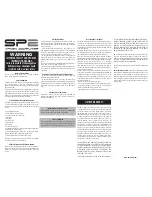
5
If you have not entered decompression, a safety stop made between 15-20
feet is strongly recommended as a standard procedure before completing your
ascent. Many divers do this to provide a wider zone of caution from the no-
decompression limit. The Tissue Loading Bar Graph gives a visual represen-
tation of just how close you came to the no-decompression limit with a yellow
“Caution Zone” (Fig. 3c). It provides a further visual indication of how close
you are to decompression. This Caution Zone portion of the TLBG allows you
to make a decision regarding safety stop duration or necessity. While you
cannot provide a guarantee against the occurrence of decompression sickness,
you may choose your own personal zone of caution based on age, physique,
excessive weight, etc., to reduce the statistical risk.
EMERGENCY DECOMPRESSION
If your depth or bottom time is such that the Tissue Loading Bar Graph
enters the red zone, the DataMax Sport will switch to
“Decompression Dive
Mode” (Fig 4) At this point, the display will change the NDC indicator to
DEC and the TLBG will indicate a decompression “
ceiling” (Fig. 4a). You
must stay below the ceiling depth indicated or risk decompression sickness.
Decompression Time Remaining (Fig. 4b) will display the total time needed
to fulfill the decompression requirement. You must stay at or a few feet
below the TLBG indicated ceiling depth until the bar graph recedes into the
yellow Caution Zone before ascending any further.
Fig. 4 – Decompression
Dive Mode
FT
FT
DEC
DEC
DataMax
SPORT
®
®
a.
b.
Summary of Contents for DataMax Sport
Page 1: ...DataMax Sport owner s guide model DRB...
Page 5: ...THE DATAMAX SPORT IS EASY TO USE...
Page 13: ...DETAILED OPERATIONS GUIDE...
Page 29: ...HANDLING THE EXTREMES...
Page 42: ...38 this page intentionally left blank...
Page 43: ...CARE and MAINTENANCE...
Page 53: ...REFERENCE...
Page 59: ...NOTES...










































